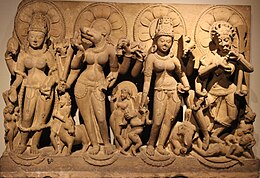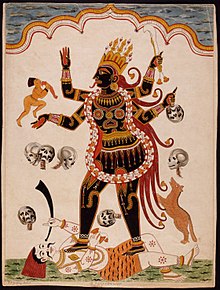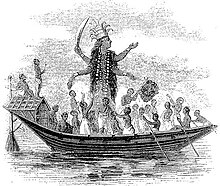沙克提派

| 印度教系列模板 |
| 印度教 |
|---|
 |
夏克提派(梵語:शाक्तं,Śāktaṃ;字面意义为「力量之教条」或「女神之教条」,也有能量之意),又譯為颯刻曇派、沙克提派、沙克達教、提毗派,中文意譯為性力派,是印度教的一个支派,专于崇拜夏克提或提毗——印度教的圣母——作为绝对的,终极的神格。该教派崇拜阴性的力量,與湿婆派、毗湿奴派并立为印度教三大派。
夏克提派认为提毗(字面意思为「女神」)是至高梵本身,「独一无二」,具有其他所有神的形式,无论其是女性或男性,都被认为是她的各种各样的權現。在该派的哲学和实践的细节上,提毗派模仿湿婆派。然而「夏克提派」(梵語:शक्त,Śakta),即提毗派的践行者,大多或全部专注于崇拜夏克提为至高之神的多变的女性一面。湿婆,神的男性一面,仅被认为是超越物质世界的,而其崇拜通常被降低到辅助角色。[1]
夏克提派的根基深植于古印度史前时期。从印度旧石器时代22,000年前的定居地已知最早的女神形象,到印度河谷文明时她的教派的改良,吠陀时期的部分衰落,之后在古典梵语传统的重新浮现和扩张,已表明在许多層面,「印度传统的历史可被视为这位女性的重现」。[2]此女神名本母(梵語:mātṛkā )。性力派在笈多王朝开始流行。
纵观其历史,性力派激发梵语文学和印度哲学的杰作,今天还在继续影响广为流传的印度教。提毗派在印度次大陆及以外,以怛特羅密教和非怛特羅密教的以无数形式广泛施行。而其最大的、最有影响力的两个派别是Śrikula(字面意义为Śri家族)——在南印度最为强大,和Kalikula(Kali家族)——在北印度和东印度盛行。[1]在印度東部、南部受雅利安人同化较少的地方继续崇拜女神。
起源與歷史
[编辑]神學
[编辑]經文
[编辑]概述
[编辑]性力派崇拜女神,认为性交是宇宙间的根本动力,是智慧和力量的集中表现。
夏克提和湿婆
[编辑]性力派信徒视女神为至高、终极的神格。她被认为是万物的起源,同时也是起源的化身和支配控制它的能量。有观察认为,「全世界信仰的历史上,没有其他任何地方经历过如我们一般,如此完整針對女性的系统」。[3]
性力派对女神的专注并不意味着其对男性或中性神明的拒绝。然而在夏克提存在中,两者被认为是不活跃的。如商羯羅的第一行的著名的性力派赞美诗美之波流(Saundaryalahari)所述:「若湿婆与夏克提结合,他可以创造(生命)。若他不与夏克提结合,他连搅动一下都不可能。[4]此为性力派之基本教义」。[5]正如广为人知的女神时母践踏于看似无生命的湿婆身躯之上的图画所强调的那样。[6]性力派供奉的主神为女神夏克提(明妃),她是「宇宙大能」的来源,她的配偶是男性湿婆,夏克提和湿婆的「永恒拥抱」(性交)构成宇宙,但其中作为动力来源的是夏克提,她的子宫是「喷出诸种能源与生命之口」,湿婆若失去她的拥抱,将只是一具「尸体」。怛特罗认为,男女交合会产生新的生命,是人世间最大的创造性能源,这一能源需与「宇宙大能」汇成一体,其仪式称为“轮宝供养”。
廣泛而言,认为夏克提是宇宙本身——她是能量和动力的具体化身,物质宇宙中所有行为和存在的背后推力。湿婆是她卓越的男性一面,为神圣的土地提供一切存在。「无夏克提即无湿婆,无湿婆即无夏克提。两者[……]本身就是一体」。[7]
与怛特罗的联系
[编辑]
性力派广泛流传的一个误解是其与怛特羅密教(怛特罗)的紧密联系。怛特罗是一个模棱两可的令人误解的概念,指称一切从南印度正统婆羅門寺庙崇拜到北印度黑魔法和隐修,以及藏密與真言宗,到西方的仪式化的性行为(「輪寶供養」,有时被称为新怛特羅)。连锡克教,耆那教与苯教也与怛特罗有关。[8]事实上,并非所有形式的性力派本质上是怛特罗,正如并非所有怛特罗本质上是性力派一样。[9]
术语「怛特罗」与正宗印度性力派相关时,它通常主要指一类宗教仪式用书,而更广泛的,是指一种秘传的专于女神的灵修方法,涉及mantra,yantra,nyasa,mudra和传统的昆达利尼瑜伽的特定元素,所有修行都在合格的导师的指导下通过适当的启发(diksha)和口头指导以补充各种书面来源。[10]
在社会影响方面,怛特罗「独立于各种种性与具体的偏见。女人或『首陀罗』被授予上师的角色。所有的女性被视为夏克提显圣,因此她们是被尊敬和效忠的对象。侵犯她们的人招致伟大女神愤怒。每个男性备修生必须了解自身之中潜在的『女性法则』,且仅以此『成为女性』才能使他被授予膜拜至高存在的资格(因此獻祭時只會用雄性牲畜)」。[11]
主要神明
[编辑]性力派信徒可以接触以多种形态中的任意一种出现的提毗;但是,他们通常被认为不过是一个至高女神的不同層面。[12]
被性力派信徒膜拜的主要的提毗形态是男性的「ishta-deva」或女性的「ishta-devi」。神祀的选择取决于许多因素,包括家族传统,信仰实践,上师沿袭,个人共鸣等等。字面上,有数千种女神形态,许多与个别寺庙、地理特征或者甚至是与某个村庄有关。[13]
坦陀罗神明
[编辑]
难近母,时母,吉祥天女,辩才天女。其实不过是大女神摩诃提毗不同形态与化身。
崇拜
[编辑]南亚次大陆有51座性力派重要庙宇,多数在东方与南方。斯里兰卡、孟加拉、尼泊尔、西藏、巴基斯坦也有。
节日
[编辑]性力派信徒庆祝大多数印度教节日,以及庞杂的本地的、特点寺庙或特定神祀的仪式。以下为一些较重要的事件:[14]
难近母节
[编辑]最重要的性力派节日是难近母节(Navaratri,字面意义为「九夜之节」),因其处在印度历Sharad月份(10/11月),亦作“Sharad Navaratri”。此节日经常与其后第10天——「Dusshera」或「Vijayadashami」一起,庆祝《女神颂》(Devi Mahatmya)中女神难近母对抗一系列强大罗刹的胜利。[15]
排灯节及其他
[编辑]是每年十月祭祀吉祥天女的节日。
寺庙
[编辑]批评与滥用
[编辑]
性力派曾被当作迷信、受黑魔法侵蚀的很难称得上真正信仰的行为,被数度解散。印度学者在1920年代曾经广泛发出过类似批评:
「怛特罗是性力派的圣经,……认为所有力量都有女性为主的本质,」 「The Tantras are the bible of Shaktism, [...] identifying all Force with the female principle in nature and teaching an undue adoration of the wives of Shiva and Vishnu to the neglect of their male counterparts. [...] It is certain that a vast number of the inhabitants of India are guided in their daily life by Tantrik teaching, and are in bondage to the gross superstitions inculcated in these writings. And indeed it can scarcely be doubted that Shaktism is Hinduism arrived at its worst and most corrupt stage of development」.[16]
密宗是夏克提派的聖經,以自然界的女性原則確認所有部隊,並教導濕婆和毘濕奴的妻子受到過度的崇拜,而忽略男性。 [...]可以肯定者,為印度的許多居民,在日常生活中都受到Tantrik教guided的指導,並受到這些著作中所灌輸的迷信束縛。的確,毫無疑問,夏克提派是印度教進入最壞,最腐敗的發展階段。”
类似言论被认为是基于外接观察者的无知、误解和偏见,以及参与者的一些不审慎的行为。「只是在这种语境下,印度的许多印度教徒今天否认怛特罗和他们的信仰曾经与现存的联系,认定他们所称的『tantra-mantra』只是如是胡謅」。
參見
[编辑]参考文献
[编辑]引用
[编辑]- ^ 1.0 1.1 Subramuniyaswami, p.1211.
- ^ Hawley. p.2.
- ^ Bhattacharyya(a), p.1.
- ^ Subramanian, p.1.
- ^ Dikshitar, p.85.
- ^ "Bengali Shakta."
- ^ Subramanian, p.ix.
- ^ Mohan's World.
- ^ Brooks(a), p.48.
- ^ Brooks(a), pp.47-72.
- ^ Bhattacharyya(a), p.131.
- ^ See Kinsley(a).
- ^ 见Kinsley(a).
- ^ Pattanaik, pp.103-109.
- ^ "5 Things You Need to Know About Navratri: The 9 Divine Nights,"最后一天要杀一头水牛,山羊,绵羊,鸡,鸭。About Hinduism (页面存档备份,存于互联网档案馆).
- ^ Kapoor, p.157.
来源
[编辑]- 书籍
- Anonymous (author), Doniger O'Flaherty, Wendy (translator), The Rig Veda: An Anthology. Penguin Classics Books (London, 1981).
- "Bengali Shakta," World Culture Encyclopedia, South Asia (页面存档备份,存于互联网档案馆)。
- (a) Bhattacharyya, N. N., History of the Sakta Religion, Munshiram Manoharlal Publishers Pvt. Ltd. (New Delhi, 1974, 2d ed. 1996).
- (b) Bhattacharyya, N. N., The Indian Mother Goddess, South Asia Books (New Delhi, 1970, 2d ed. 1977).
- Bolon, Carol Radcliffe, Forms of the Goddess Lajja Gauri in Indian Art, The Pennsylvania State University Press (University Park, Penn., 1992).
- (a) Brooks, Douglas Renfrew, The Secret of the Three Cities: An Introduction to Hindu Shakta Tantrism, The University of Chicago Press (Chicago, 1990).
- (b) Brooks, Douglas Renfrew, Auspicious Wisdom: The Texts and Traditions of Srividya Shakta Tantrism in South India, State University of New York Press (Albany, 1992).
- (a) Brown, C. MacKenzie, The Triumph of the Goddess: The Canonical Models and Theological Issues of the Devi-Bhagavata Purana, State University of New York Press (Suny Series in Hindu Studies, 1991).
- (b) Brown, C. Mackenzie. The Devi Gita: The Song of the Goddess: A Translation, Annotation and Commentary. State University of New York Press (Albany, 1998).
- Coburn, Thomas B., Encountering the Goddess: A translation of the Devi-Mahatmya and a Study of Its Interpretation. State University of New York Press (Albany, 1991).
- Dempsey, Corinne G., The Goddess Lives in Upstate New York: Breaking Convention and Making Home at a North American Hindu Temple. Oxford University Press (New York, 2006).
- Dikshitar, V. R. Ramachandra, The Lalita Cult, Motilal Banarsidass Publishers Pvt. Ltd. (Delhi, 1942, 2d ed. 1991, 3d ed. 1999).
- Erndl, Kathleen M., Victory to the Mother: The Hindu Goddess of Northwest India in Myth, Ritual, and Symbol, Oxford University Press (New York, 1992).
- Harper, Katherine (ed.), The Roots of Tantra, State University of New York Press (Albany, 2002).
- Hawley, John Stratton (ed.) and Wulff, Donna Marie (ed.), Devi: Goddesses of India. University of California Press (Berkeley, 1996).
- (a) Johnsen, Linda. The Complete Idiot's Guide to Hinduism. Alpha Books (Indianapolis, Ind., 2002).
- (b) Johnsen, Linda, The Living Goddess: Reclaiming the Tradition of the Mother of the Universe." Yes International Publishers (St. Paul, Minn., 1999).
- Joshi, L. M., Lalita Sahasranama: A Comprehensive Study of the One Thousand Names of Lalita Maha-tripurasundari. D.K. Printworld (P) Ltd (New Delhi, 1998).
- Kali, Davadatta, In Praise of the Goddess: The Devimahatmya and Its Meaning. Nicolas-Hays, Inc., Berwick, Maine, 2003).
- Kapoor, Subodh, A Short Introduction to Sakta Philosophy, Indigo Books (New Delhi, 2002, reprint of c. 1925 ed.).
- (a) Kinsley, David. Hindu Goddesses: Visions of the Divine Feminine in the Hindu Religious Tradition. University of California Press (Berkeley, 1988).
- (b) Kinsley, David. Tantric Visions of the Divine Feminine: The Ten Mahavidyas. University of California Press (Berkeley, 1997).
- Krishna Warrier, Dr. A.J., The Sākta Upaniṣad-s, The Adyar Library and Research Center, Library Series, Vol. 89; Vasanta Press (Chennai, 1967, 3d. ed. 1999).
- Kumar, Girish, "Introduction to Tantra Sastra, Part I." Interview with Sri Girish Kumar, former director of Tantra Vidhya Peethama, Kerala, India, Mohan's World
- Müller, F. Max (translator), The Upanishads. Realization.org (页面存档备份,存于互联网档案馆)
- Nikhilananda, Swami (trans.), The Gospel of Sri Ramakrishna, Ramakrishna-Vivekananda Center (New York, 1942, 9th ed. 2000).
- Pattanaik, Devdutt, Devi the Mother-Goddess: An Introduction. Vakils, Feffer and Simons Ltd. (Mumbai, 2000).
- Pechilis, Karen (ed.), The Graceful Guru: Hindu Female Gurus in India and the United States. Oxford University Press (New York, 2004).
- Sarma, Dr. S. A., Kena Upanisad: A Study From Sakta Perspective. Bharatiya Vidya Bhavan (Mumbai, 2001).
- (a) Shankarnarayanan, S., The Ten Great Cosmic Powers: Dasa Mahavidyas. Samata Books (Chennai, 1972; 4th ed. 2002).
- (b) Shankarnarayanan, S., Sri Chakra. Samata Books (Chennai, 1971; 4th ed. 2002).
- Subramanian, V. K., Saundaryalahari of Sankaracarya: Sanskrit Text in Devanagari with Roman Transliteration, English Translation, Explanatory Notes, Yantric Diagrams and Index. Motilal Banarsidass Publishers Pvt. Ltd. (Delhi, 1977; 6th ed. 1998).
- Subramuniyaswami, Satguru Sivaya, Merging with Siva: Hinduism's Contemporary Metaphysics, Himalayan Academy (Hawaii, USA, 1999).
- Suryanarayana Murthy, Dr. C., Sri Lalita Sahasranama with Introduction and Commentary. Bharatiya Vidya Bhavan (Mumbai, 2000. Rep. of 1962 ed.).
- Urban, Hugh B., Tantra: Sex, Secrecy, Politics and Power in the Study of Religion, University of California Press (Berkeley, 2003).
- Vanamali, Mataji Devi, Shakti: Realm of the Divine Mother, Inner Traditions (Rochester, Vermont USA, 2008).
- White, David Gordon, Kiss of the Yogini: "Tantric Sex" in its South Asian Contexts, The University of Chicago Press (Chicago, 2003).
- Winternitz, M., History of Indian Literature, 2 vols. (Calcutta, 1927, 1933, rep., New Delhi, 1973).
- Woodroffe, Sir John, Sakti and Sakta: Essays and Addresses, Ganesh & Company (Madras, 9th Ed. 1987, reprint of 1927 edition).
- Yadav, Neeta, Ardhanārīśvara in Art and Literature. D. K. Printworld (P) Ltd. (New Delhi, 2001).
| ||||||||||||||||||||||||||||||||||||||||||||||||||||||||||||||||||||||||||||||||||||||||||||||||||||||||||||||||||||||||||||||||||||||
| |||||||||||||||||||||||||||||||||||||||||



